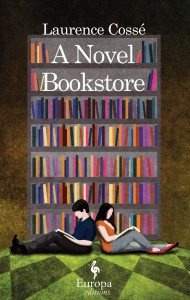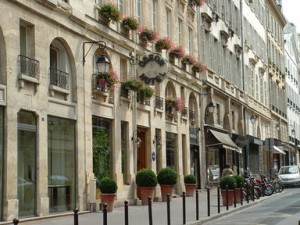“We have no time to waste on insignificant books, hollow books, books that are here to please…We want books that cost their authors a great deal, books where you can feel the years of work, the backache, the writer’s block, the author’s panic at the thought that he might be lost…We want books that immerse us in the splendor of reality and keep us there…We want good novels.”
Probabl y every lover of literary fiction has had a fantasy about creating or finding the ideal bookstore—one which is dedicated to exactly the kinds of novels we like to read, where we can enter and spend an afternoon browsing, reading whatever strikes our eye, all the while knowing that every book there has the potential to become one of our favorites. It is a fantasy in which all the other browser-readers there enjoy reading and talking about the same kinds of books we do, and the helpful staff has read most of the books and can make recommendations. The main characters in this novel by Laurence Cosse have created just such a bookstore. Ivan (Van) Georg, who manages a shop called The Good Novel, and Francesca Aldo-Valbelli, the heiress who is supporting it financially, have committed themselves to a shop which is not “an ordinary bookstore…[and] our customers [are not] ordinary customers.”
y every lover of literary fiction has had a fantasy about creating or finding the ideal bookstore—one which is dedicated to exactly the kinds of novels we like to read, where we can enter and spend an afternoon browsing, reading whatever strikes our eye, all the while knowing that every book there has the potential to become one of our favorites. It is a fantasy in which all the other browser-readers there enjoy reading and talking about the same kinds of books we do, and the helpful staff has read most of the books and can make recommendations. The main characters in this novel by Laurence Cosse have created just such a bookstore. Ivan (Van) Georg, who manages a shop called The Good Novel, and Francesca Aldo-Valbelli, the heiress who is supporting it financially, have committed themselves to a shop which is not “an ordinary bookstore…[and] our customers [are not] ordinary customers.”
A committee of eight writers representing different styles of novels is chosen in secret to make the selections of books for the shop, each member having a pen name so that no one, not even other committee members, knows their identities. With a choice Parisian location near the famed Odeon Theatre, the shop opens to customers in August, with the biggest percentage of their “good books” representing the best of French literature. The shop is mobbed from the outset, with seven hundred eleven novels being sold on the first day alone. By Christmas time, the shop is a huge success.

But success has come at a price. Large numbers of new customers have begun to order pop novels, then fail to pick them up, leaving the shop to pay for them. Nasty comments appear on their internet forum, and a seemingly organized attack is mounted in the press, with accusations of elitism taking up whole pages, At one point the shop is described as a “totalitarian undertaking,” an attempt by a small group of elite to control the reading done by the public. Fascist accusations result. Ugly posters are plastered all over town, and demands are made that the shop’s financial backer be unmasked.
Eventually, three attempts to murder members of the secret selection committee, described in the opening pages of the novel, involve the police. Throughout the attacks, both physical and in print, the author raises questions of who benefits from the destruction of one small bookstore and its people. Resentful owners of other bookstores? A general public insulted by the shop’s cultural snobbery? Publishers of new novels which have not “made the cut” for inclusion at the shop? A cabal of disaffected authors whose books are not carried by the shop? When several new bookstores open adjacent to or across the street from The Good Novel, sales at The Good Novel plummet.
A combination of myster y, fantasy, philosophical analysis, and economic treatise on the book industry, A NOVEL BOOKSTORE raises many interesting questions within a unique story. The novel does have its problems, however. A love story involving manager Van and Anis, a wispy and only vaguely attentive young woman, is unsatisfying on every level, as Van seems to have no understanding of himself or of her. She, in turn, seems to be equally dim, an almost ghostly presence flitting through the novel. The mystery is not well integrated. The attempts at murder described in the beginning of the novel gain little attention for most of the novel as the ins and outs of book shop business and publishing dominate the “action.” In fact, some of the most interesting sections of the novel are those related to the decisions of what books to include on the shelves, Cormac McCarthy being the most popular choice among American authors.
y, fantasy, philosophical analysis, and economic treatise on the book industry, A NOVEL BOOKSTORE raises many interesting questions within a unique story. The novel does have its problems, however. A love story involving manager Van and Anis, a wispy and only vaguely attentive young woman, is unsatisfying on every level, as Van seems to have no understanding of himself or of her. She, in turn, seems to be equally dim, an almost ghostly presence flitting through the novel. The mystery is not well integrated. The attempts at murder described in the beginning of the novel gain little attention for most of the novel as the ins and outs of book shop business and publishing dominate the “action.” In fact, some of the most interesting sections of the novel are those related to the decisions of what books to include on the shelves, Cormac McCarthy being the most popular choice among American authors.
A peripheral issue may provide more insight into publishing than the novel itself. A website at http://www.thegoodnovel.com/ appears to be the real life equivalent of the shop in this book. This website and its Facebook equivalent appear in every way to be real—until the reader looks up the details and discovers that there is no bookshop listed at this address in Paris, the quotations from “famous people” exist only on the website, the quoted magazines or papers do not exist, and there is no phone number or way to place orders. I do not know who is responsible for this web page or the Facebook page, but it is the cleverest, most imaginative book advertising I’ve seen since Orhan Pamuk created a real Museum of Innocence after writing his novel of that title. The website will certainly generate more publicity for great writing and “Good Novels,” and that’s what we all want. Do take a look at it. It’s fun!
Photos, in order: The author’s photo is from www.arianne.fr
The streetscape near the Odeon, where The Good Novel is said to be located, might have looked like the one above at rue de l’Odeon, Paris, FR, Postal code: 75006. www.mapmonde.org
The profile for The Good Novel is here: http://www.thegoodnovel.com/
ALSO by Cosse: AN ACCIDENT IN AUGUST
